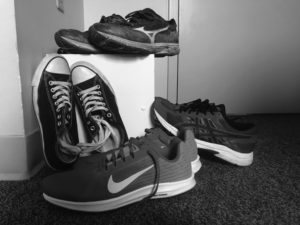If the shoe fits: the importance of proper gear in athletic competition

When partaking in a sport or other form of physical activity, one feature that may be overlooked or under emphasized is shoes. Wearing the wrong type of shoe for the wrong activity not only causes discomfort, it’s also a leading factor in injuries!
Think of it this way: would it make sense for a basketball player to wear football cleats? What about a tennis player wearing spikes designed for the long jump in track and field? While those examples seem rather extreme, the point is that certain types of athletic shoes are designed for specific terrains.
One factor that accounts for this is “grip.” Grip is the force that allows your feet to be planted to a surface without slipping or sliding while having enough bounce to easily propel you in the right direction.
For example, basketball shoes are designed for flexible moving, while running shoes are designed to be lightweight yet “cushioned” enough to withstand repetitive strikes against the ground with your body weight. Some shoes are designed to house little needles, referred to as “spikes,” to enhance the grip in the shoe. These are mainly used in cross country and track to propel runners forward to enhance race performance.
Another factor that influences one’s pair of shoes is the nuances of one’s individual feet. Athletic shoes are designed for all kinds of foot styles, including the arch of the foot and pronation, meaning the rotation of the foot. Wearing shoes that do not support one’s individual rotation can result in injury and increase the amount of negative stress on the shoe. Arch supports can also be put in your shoes to alleviate any discomfort. While seemingly menial, knowing your step and level of support enhances your performance by focusing on the muscle groups that matter most in your respective activities.
Taking up running? Rather than driving to a generic sports store, local stores such as Runner’s Market or Fleet Feet in West Knoxville can evaluate you to determine your foot strike and other factors to determine a proper “shoe prescription.”
While running shoes are pricier, it beats the risk of getting injured. Luckily, some stores even offer student discounts to help offset the cost. A general rule of thumb is to replace running shoes after 250-500 miles, depending on how often shoes are used and your primary running surface, whether that be pavement or trails.
Hiking is another activity that should be in consideration when purchasing a pair of athletic shoes. Hiking shoes are designed sturdier and bulkier to protect your foot against the elements and to help traverse unsettling terrains. While Chacos (even while wearing socks) are seen as the “go-to outdoors shoes,” they do not protect your feet in colder temperatures and surfaces that require more grip to be balanced.
For shorter hikes, a sturdy pair of tennis shoes may be okay, but harder and rockier trails are best suited with sturdier shoes, which can be found at stores such as Little River or REI.
Regardless of your intention, equipping yourself with the right shoe is a crucial way to reduce your risk of athletic injury and increase your potential in the activity of your choosing. Shoes are an investment, and as menial as it may seem, they are a vital asset in keeping you safe and active.
